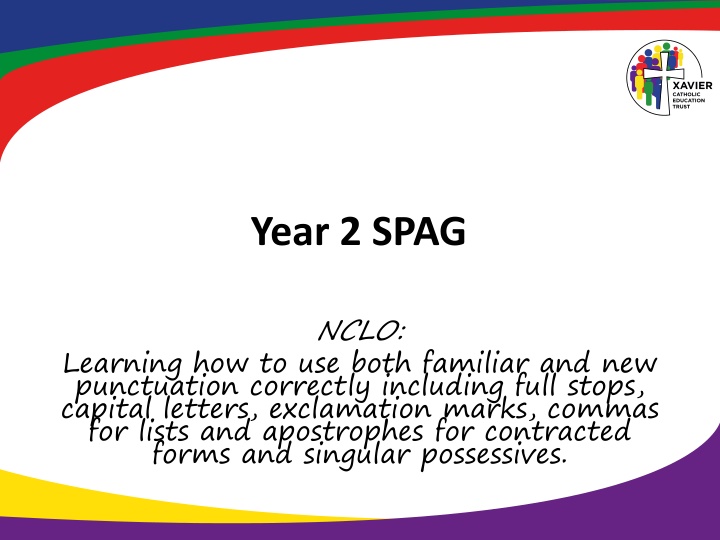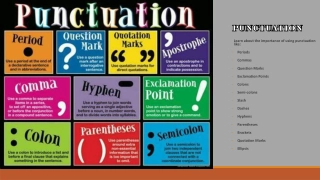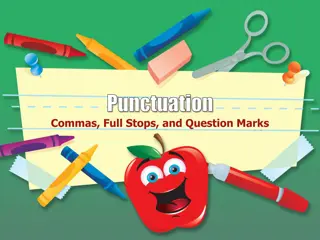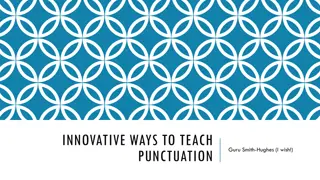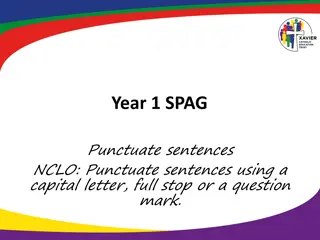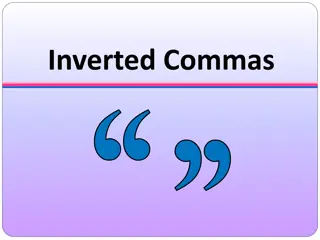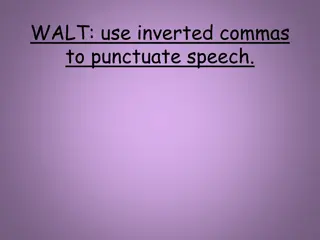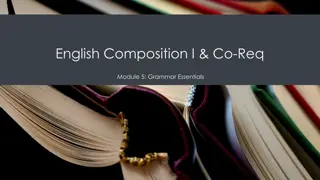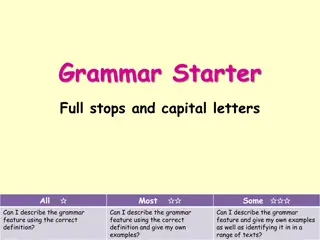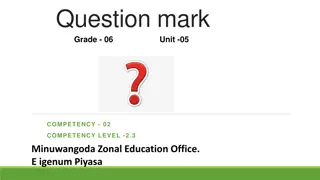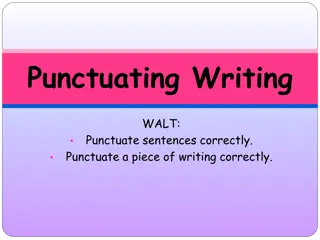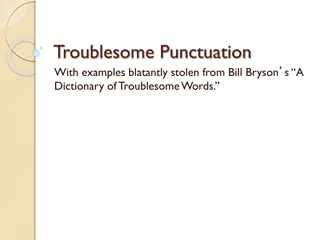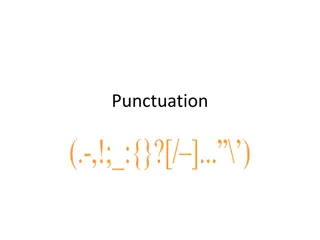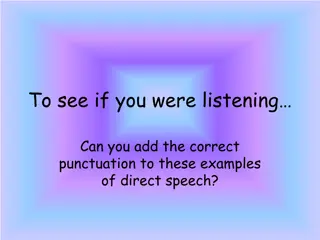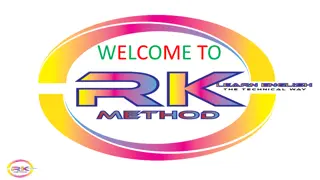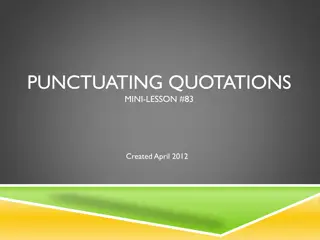Mastering Punctuation: Full Stops, Capital Letters, Exclamation Marks, Question Marks
Learn the correct usage of full stops, capital letters, exclamation marks, and question marks. Understand when to use each punctuation mark to enhance the clarity and impact of your writing. Explore examples and guidelines for both familiar and new punctuation rules in English.
Download Presentation

Please find below an Image/Link to download the presentation.
The content on the website is provided AS IS for your information and personal use only. It may not be sold, licensed, or shared on other websites without obtaining consent from the author.If you encounter any issues during the download, it is possible that the publisher has removed the file from their server.
You are allowed to download the files provided on this website for personal or commercial use, subject to the condition that they are used lawfully. All files are the property of their respective owners.
The content on the website is provided AS IS for your information and personal use only. It may not be sold, licensed, or shared on other websites without obtaining consent from the author.
E N D
Presentation Transcript
Year 2 SPAG NCLO: Learning how to use both familiar and new punctuation correctly including full stops, capital letters, exclamation marks, commas for lists and apostrophes for contracted forms and singular possessives.
. Full Stop . Full stops are used: to mark the end of a sentence: By the time she was three, Matilda had taught herself to read by studying newspapers and magazines that lay around the house. to mark the end of a group of words that is not a full sentence, but which is complete in itself: Over and over. Again and again. Relentlessly. after abbreviations that consist of the first part of a word: Sept. Thurs. in email and website addresses: www.roalddahl.com
CAPITAL LETTERS Capital letters are used: for the first letter of a sentence: Nearly every weekday afternoon Matilda was left alone in the house. for the first letters of the names of people, places and special days: Roald Dahl United Kingdom New Year s Day for the first letters of the main words of the titles of books, plays, newspapers and magazines: The Evening Standard James and the Giant Peach for the first letters of the main words of the titles of people and institutions: The Prime Minister The House of Parliament in initialisms, when the words they represent also normally begin with a capital letter: USA HSBC
! Exclamation mark ! The main use of the exclamation mark is to end sentences that express: an exclamation: I wish to heavens I was still allowed to use the birch and belt as I did in the good old days! I d have roasted Matilda s bottom for her so she couldn t sit down for a month! Mrs Trunchbull exclaimed. direct speech spoken loudly or shouted: I haven t touched the flaming stuff! Mr Wormwood shouted. something that the writer or speaker finds amusing: Her son was the biggest poacher he was the devil: he d rob your house in the middle of the day and let you see him! It can also be used in brackets after a statement that the writer finds amusing or ironic: I look ruddy, muscly, well covered (!) and just, shall we say, solid.
? Question mark ? The question mark is used to mark the end of a question. What is your name? It can also be used in brackets to indicate that the writer believes that a statement is doubtful or questionable: All was going well until a passing lad with a sense of fun (?) pulled out the plug.
, Commas , Commas are used: to separate items in a list: I visited New York, Paris and London. to mark off an introductory clause or adverbial in a sentence: You learn a lot in three hours,. Unfortunately, you also forget a lot after a couple of days. in pairs to place a section of a sentence in parenthesis (as brackets do): James, a 23-year-old beggar from Hale, left his 4-million-pound mansion to live on the streets. to mark the divisions between the clauses in a complex sentence: These weedkillers may, if used on new lawns, damage young seedling grasses before they are well established.
, Commas , Commas are used: to mark off a non-defining (non-restrictive) relative clause: As a young man especially, it was necessary for him to be frugal, to try to amass some money, which he gradually did. to separate sections of a sentence to make it easier to read: To make a hot compress, pour hot water into a bowl and then add the essential oil. to introduce and/or end a piece of direct speech: No, sir, said Stephen, and that is what is so curious. in numbers: 3,092,782 5,391.00
apostrophe The apostrophe is used: to show that one or more letters have been missed out: will not won t shall not shan t might have might ve she is she s they are they re let us let s o clock of the clock fo c s le forecastle tis it is o er over I s pose so. I suppose so.
apostrophe The apostrophe is used: to show possession: Lord Rochester s monkey The girl s handbag The Browns Silver Wedding anniversary The rules are: If the name or noun is in the singular, we add an apostrophe followed by the letter s. If the name or noun is a plural ending in s then we simply add an apostrophe. Plurals that do not end in s follow the rule for singular nouns: A children s playground
